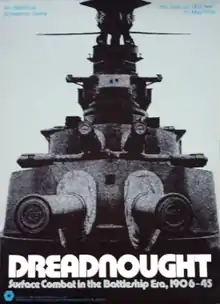Dreadnought (naval wargame)
Dreadnought, subtitled "Surface Combat in the Battleship Era, 1906-45", is a naval board wargame published Simulations Publications, Inc. (SPI) in 1975.
| Surface Combat in the Battleship Era, 1906-45 | |
|---|---|
 Cover of the flat-box version, 1975 | |
| Designers | John Michael Young Irad B. Hardy, III |
| Publishers | Simulations Publications, Inc. |
| Years active | 1975 |
| Players | 2 |
| Playing time | 120 minutes |
| Age range | 12 and up |
Description
Dreadnought is a wargame that simulates battles between battleships.
Components
The game includes:[1]
- Six 10" x 10.75" plain hex grid map sections scaled to 1800 m (1968 yd) per hex
- 400 die-cut counters
- 16-page rulebook
- 2 Player Aid Cards
- Orders Pad
- two 6-sided dice
Gameplay
Counters are provided for every battleship that sailed from 1906 tp 1945.[2] Several historical and hypothetical scenarios are provided. Each game turn represents 15 minutes of game time. Elements of pre-radar ship-to-ship combat are present, including rangefinding, torpedoes, gunnery, and damage control.[1] If ships sail off the edge of the map, another map piece is placed so that the map is extended in that direction.
Publication history
Dreadnought was designed by Irad B. Hardy and John Young, with artwork by Redmond A. Simonsen. It was published by SPI in 1975 as a full-sized boxed set and as a flat-box with a clear plastic lid. It was a bestselling game for SPI, rising to the top of SPI's Top 10 list the month after it was released, and staying in the Top 10 for a year.[3]
Reception
In his 1977 book The Comprehensive Guide to Board Wargaming, Nicholas Palmer called Dreadnought "an excellent game" and noted "Rather unusually in a naval game, the accent is on playability rather than enormous detail, and the result is fast-moving and frequently tensely exciting."[4]
In Issue 24 of Moves, Steve List compared Dreadnought to Avalon Hill's Jutland, and found that complex maneuvering in Jutland is difficult, but "since [Dreadnought's] mechanics of movement are simple and straight-forward. intricate maneuvers are quite feasible and can be considered the main point of the game." While List found that "Dreadnought is far more convenient to play", he thought that "Anyone interested in naval warfare should have both games in his collection."[2]
In a 1977 poll of wargamers conducted by SPI to determine the most popular of 205 wargames published by various companies, Dreadnought placed 7th.[4]
Other reviews
- The Wargamer, Vol.2 #24
- Phoenix #23
- Pursue & Destroy Vol.3, #1
References
- "Dreadnought: Surface Combat in the Battleship Era, 1906-45 (1975)". boardgamegeek.com. Retrieved 2021-05-27.
- List, Steve (January 1976). "Comparative Evaluation: Dreadnught & Jutland". Moves. No. 24. pp. 11–12.
- "SPI's Bestselling Games - 1975". spigames.net. Retrieved 2021-05-27.
- Palmer, Nicholas (1977). The Comprehensive Guide to Board Wargaming. London: Sphere Books. pp. xxx.